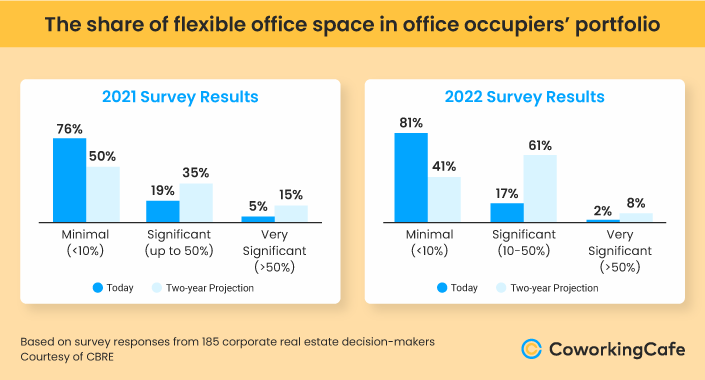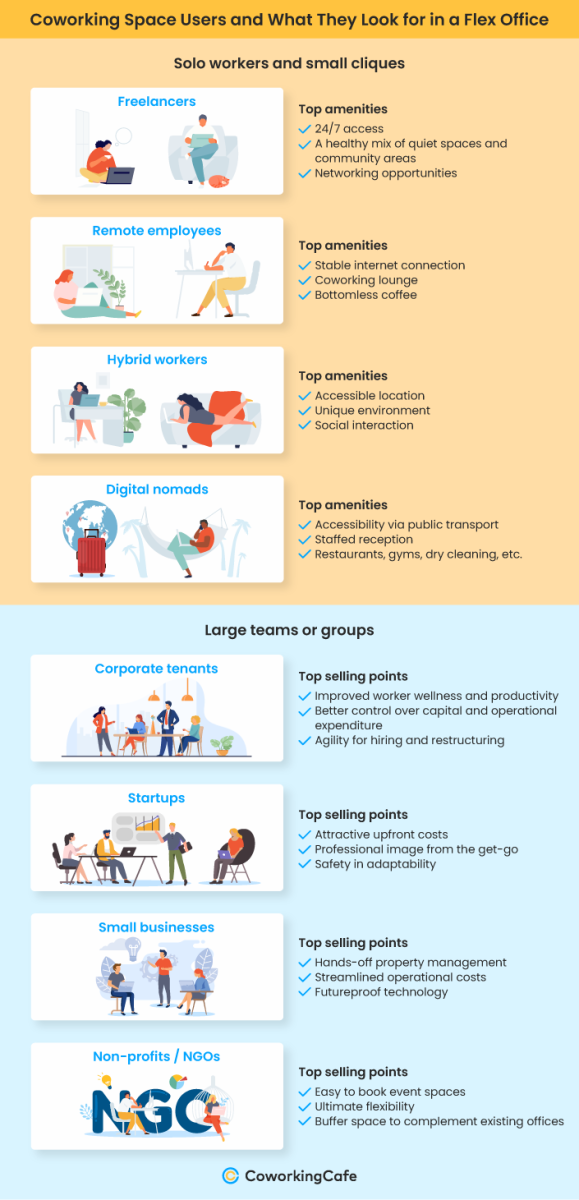Coworking spaces have become increasingly popular in recent years as businesses and individuals are looking for more flexible and affordable office options. And they’re not just growing in numbers, but also in diversity as people and organizations driven by different objectives are discovering the benefits of coworking offices.
Peggy Sue Loroz, Professor of Marketing at Gonzaga University School of Business Administration suggests a pragmatic approach when thinking about the needs of coworking space users. “In general, the differences between individuals and companies looking at coworking spaces center around the fact that an individual is typically thinking about their own needs and preferences, while a company is thinking about the cost structure and productivity of the business as a whole, while recognizing employees and their well-being as critical to business success.”
As Indranil Goswami, Assistant Professor of Marketing at the University at Buffalo puts it, “individual motivation and preferences might differ from a company’s motivation and preferences regarding attitude towards choosing a coworking space, depending on the type of work or the industry. For creative work, companies and individual attitudes might be in sync, and both might recognize that flexible options are better,” Goswami told CoworkingCafe. “If you extend this to organizations that are primarily client-facing, e.g., call centers – we might again see less of a conflict in attitudes and companies and individuals might both agree that opening toward coworking facilities is important for instance to avoid call drops, etc,” he added.
With so many categories of potential users to differentiate between, it seems that it makes sense to split them in two major groups: individuals and companies. All the more so because you wouldn’t market your services the same way to solo clients (B2C) as you would to representatives of larger organizations (B2B) who base their decisions on different criteria.
At a Glance
Solo workers and small cliques |
Large teams or groups |
||
| Client profile | Top amenities | Client profile | Top selling points |
| Freelancers
|
|
Corporate tenants
|
|
| Remote employees
|
|
Startups
|
|
| Hybrid workers
|
|
Small businesses
|
|
| Digital nomads
|
|
Non-profits / NGOs
|
|
Group 1 — Solo workers and small cliques
This is the most obvious target audience, especially in this post-pandemic climate. With home-office becoming pretty much the norm at many companies, not to mention the thriving gig-economy, office workers and independent contractors are driving a considerable portion of the demand for flexible workspace.
Whether their motivation is more social interaction, permanent access to a well-equipped office or meeting room, or just the occasional change of scenery, coworking spaces are an obvious choice for solopreneurs, dynamic duos, as well as small teams.
E. Scott Lathrop, Professor of Marketing Practice at Syracuse University thinks it’s reasonable to expect search parameters used by individuals to be different from those used by organizations when looking for flexible office space. “In fact, both the decision attributes (that is, the features considered) and the weights assigned to those attributes would differ,” Lathrop said. “While cost would be an important consideration for all, individuals might be much more likely to search and decide based on what we might refer to as ‘comfort’ factors — things like the ambience of the workspace, welcoming social atmosphere, amenities (coffee, snacks), and proximity to home,” he added.
Loroz thinks work-life balance isn’t the only key driver for solo clients. “An individual might also be looking for a flexible office because they want a professional workspace outside of their home, either to help with or to create a more appropriate environment for client meetings. They might also be interested in the social and networking opportunities that a coworking space can offer,” she said “Motivations for these folks might be focused inward — ‘I feel more professional/productive/creative/connected in this workspace’ — or outward — ‘Others will see me as more professional if I use this type of workspace’ — or —Business opportunities may come my way from working in this space,” the Gonzaga University professor pointed out.
To set yourself up for success with the following types of solo clients, it’s best to employ B2C strategies such as opening your marketing funnel as wide as your budget allows while maintaining a smooth customer experience. To really resonate with solo clients, make sure your messaging is as clear, consistent and on-brand as possible, and aim to strike some chords with your copy.
-
The Freelancer
Coworking spaces check all the boxes when it comes to the flexibility needs of the typical freelancer. After all, the main attraction of the freelance lifestyle is that it allows to work from anywhere, and anytime. It’s easy to see then why they have no interest in committing to a long-term lease, so a flexible plan is a must-have when targeting freelancers.
However, the freedom of the independent lifestyle also carries a burden. Most freelancers work alone, and their craving for a sense of community makes kitchen and lounge areas a popular spot. Even better if there’s a game room too. But it’s imperative at the same time that they have distraction-free work areas where they can focus all their attention to their project.
Features freelancers look for in a coworking space:
- 24/7 access
- A healthy mix of quiet spaces and community areas
- Networking opportunities
-
The Remote Employee
A growing number of people are working remotely, and not just as an after-effect of the pandemic. Employees can land their dream job over the internet, and companies are always just clicks away from hiring the best talent. Also, even if they’re in the same city, it’s often cheaper for companies to pay for coworking subscriptions than leasing and maintaining an office building, so remote work really is a win-win.
However, regardless if their employer is a few corners or several time zones away, remote employees need rock-solid internet connection. Dual-ISP connectivity is usually music to their ears, and they also love docking stations as these allow for a more stable wired connection — in addition to the obvious benefit of multiple large screens and comfortable peripherals.
Similarly to the freelancer lifestyle, remote working also makes for quite an isolated existence, so this demographic also appreciates the social element of coworking spaces.
Features remote employees look for in a coworking space:
- Stable internet connection
- Coworking lounge
- Bottomless coffee
-
The Hybrid Worker
A coworking space in an easily accessible part of town may be the sweet spot between the office and working from home for hybrid workers too. While for fully remote employees their living room is often the only alternative to a coworking office, hybrid workers already have two options to begin with. However, it’s not that difficult for a coworking space to compete with either of them.
There’s good reason hybrid workers are regular clients at coworking offices despite having plenty of choice. Once a company adopts a hybrid working policy, the office atmosphere changes. People who thrive in a highly active environment simply need more social stimulation than they get on a slower day at their usual office.
Features hybrid workers look for in a coworking space:
- Location, location, location
- Unique environment
- Social interaction
-
The Digital Nomad
This category is highly diverse. A digital nomad could very well be a freelancer or a traveling / delegated employee, but they could also be people on a “workation” — for example a remote employee who wants to discover a new city each month after their work hours, or someone building a side hustle while on vacation or a longer sabbatical between jobs.
Given their diverse background, they’re a difficult audience market to. Not because they’re harder to please than other clients (on the contrary), but because there’s no universal approach that would appeal to all digital nomads. The only common theme is that they’re probably new to your city. Therefore, anything that helps them find their way around the city or make them feel at home will make their experience memorable — small gestures can have a big effect and help kickstart the word-of-mouth within the community.
Features digital nomads look for in a coworking space:
- Accessibility via public transport
- Staffed reception
- Restaurants, gyms, dry cleaning, etc. nearby
Group 2 — Large teams or groups
The emergence of the corporate coworker is one of the major trends transforming the flexible office sector. Companies have been leaning towards decentralizing work and diversifying their office space ever since the early days of the pandemic. Embracing coworking spaces not only allows them to accommodate staff members who prefer to work remotely, but also to enter new markets more easily, to test new working models, and not least to reduce capital expenditure.
A CBRE survey conducted in 2021 highlights that companies with 10,000 or more employees are leading the way in adopting coworking solutions. One in five mammoth employers projected that at least half of their portfolio will be made up of flexible office space by 2023, and one in three reckoned coworking hubs would amount for 11% to 50% of their total office space. An early evidence of this transition is that by early 2021 more than half of WeWork members were employees of large organizations — Amazon, Airbnb, GE, HSBC, IBM, Microsoft and Salesforce, to name a few of the coworking operator’s known corporate clients.
Although the 2022 iteration of the same survey doesn’t break down projections by company size, the follow-up round confirms that as a general trend, the optimism regarding flex offices remains and continues to grow.

Peggy Sue Loroz agrees that companies are drawn to the idea of a more cost-effective option for office space. ” The primary motivation for companies is to balance the cost of various office space options against objectives that seek to maximize productivity while enabling a business to attract and retain talented employees,” she said, “A coworking office can provide a flexible and scalable solution for a company that is growing, downsizing, or experimenting with hybrid work arrangements. In addition, a coworking space can create a collaborative and dynamic environment for employees, which can be good for morale and creativity.”
E. Scott Lathrop sees companies placing a higher priority and weight on “efficiency” factors — things like opening hours, internet speed, copying facilities, and Zoom meeting capabilities. “If confidentiality is an issue or the work involves proprietary information, the ability for company employees to work in an isolated space separated from others using the facility might also be an important factor,” he pointed out.
As opposed to the more transactional marketing that works well with solo workers, organizations and corporate clients require a more personal touch. Niched targeting is preferred to a blanket approach, and branding efforts are better focused on market positioning rather than the actual messaging. However, making room for open, two-way communication is just as important, and so is speaking the same language in terms of the terminology used as well as the processes employed. At the end of the day, the goal is to build long-term relationships.
-
Corporate Tenants
Businesses increasingly favor flexible workspaces over conventional offices for a variety of reasons, including better access to premium workplaces in desirable office locations and crossing office upkeep off their to-do lists. Again, a win-win, as in addition to the immediate surge in occupancy upon a signing the contract, the long-term commitments provide coworking operators with a consistent source of revenue, unlocking rapid growth.
Large businesses prefer spacious private offices with personalized branding, thus the goal is to design those modern, well-equipped offices for them. Advanced technology is also vital, such as a system for reserving conference spaces, cloud printing, access control, etc. You’ll need coworking space software that incorporates all of this into easy-to-use member mobile apps.
Why corporate tenants choose coworking spaces:
- Improved worker wellness and productivity
- Better control over capital and operational expenditure
- Agility for hiring and restructuring
-
Startups
Although at first glance the main sentiment surrounding startups tends to be optimism, today’s entrepreneurs are painfully aware of other side of the coin. The pandemic served not only as a springboard for new business initiatives, but also as a stark reminder of the consequences of overspending and the importance of maintaining a short reaction time. The same volatilities that fuel the hope of overnight success can also spell disaster, especially for a small company to which a month’s lease can mean the difference between survival and bankruptcy in a time of crisis.
Therefore, flexibility is not just a nice-to-have, but essential for any early-stage company. The same is true for networking opportunities. Consequently, the affordable office spaces with short-term leases, as well as access to other likeminded businesspeople and resources to help accelerate growth make coworking spaces an easy pitch for startups.
Why startups choose coworking spaces:
- Attractive upfront costs
- Professional image from the get-go
- Safety in flexibility
-
Small Businesses
This category, although similar to startups to some degree, is worth discussing separately. Surprisingly, since these small teams are often local businesses, they might negotiate for more individual workspaces at one coworking office than some multinational companies. And although most of them are established businesses, they might struggle to find affordable office space that meets their needs, especially in a large city.
The gap between what the office staff of most small businesses needs to operate and what most coworking spaces offer has all but disappeared. At the very least, it’s shrunk to the point where maintaining a traditional office and keeping its tech infrastructure up to date won’t be viable for long. So in terms of targeting small businesses, they’re more similar to corporations when it comes to their pain points.
Why small businesses choose coworking spaces:
- Hands-off property management
- Streamlined operational costs
- Futureproof technology
-
Non-Profits, NGOs, etc.
Granted, not the most common tenants at flex offices — depending on the given setup, — such organizations can be a viable target audience for coworking spaces. With ever-fluctuating budgets and head counts, the flexibility of the coworking concept may appeal to non-profits and other non-governmental organizations for their everyday operations. The duality of having limited resources but addressing large communities also makes it so that charitable groups often need short-term access to large conference rooms to accommodate their meetings, training sessions, and community events.
However, it’s not just the lounges and meeting rooms that non-profits might find attractive. Coworking spaces can be a great platform for them to collaborate with other organizations and get the most out of their limited manpower. As a temporary expansion, a coworking space may also serve as their second home while working on projects involving more people than their own spaces can handle at normal capacity.
Why non-profits and NGOs choose coworking spaces:
- Easy to book event spaces
- Ultimate flexibility
- Buffer space to complement existing offices
Final thoughts
Coworking spaces are a great option for any of these customer types. Whether they are solo clients or corporate teams, putting effort into understanding the needs of your potential coworking clients is instrumental for the long-term success of any flexible office.
We hope this article provided useful insight into the types of individuals who can use a coworking office, and helps get the ideas flowing when it comes to marketing your services to them. Do it right and you’ll convert individual and corporate leads into your next coworking clients in no time.








